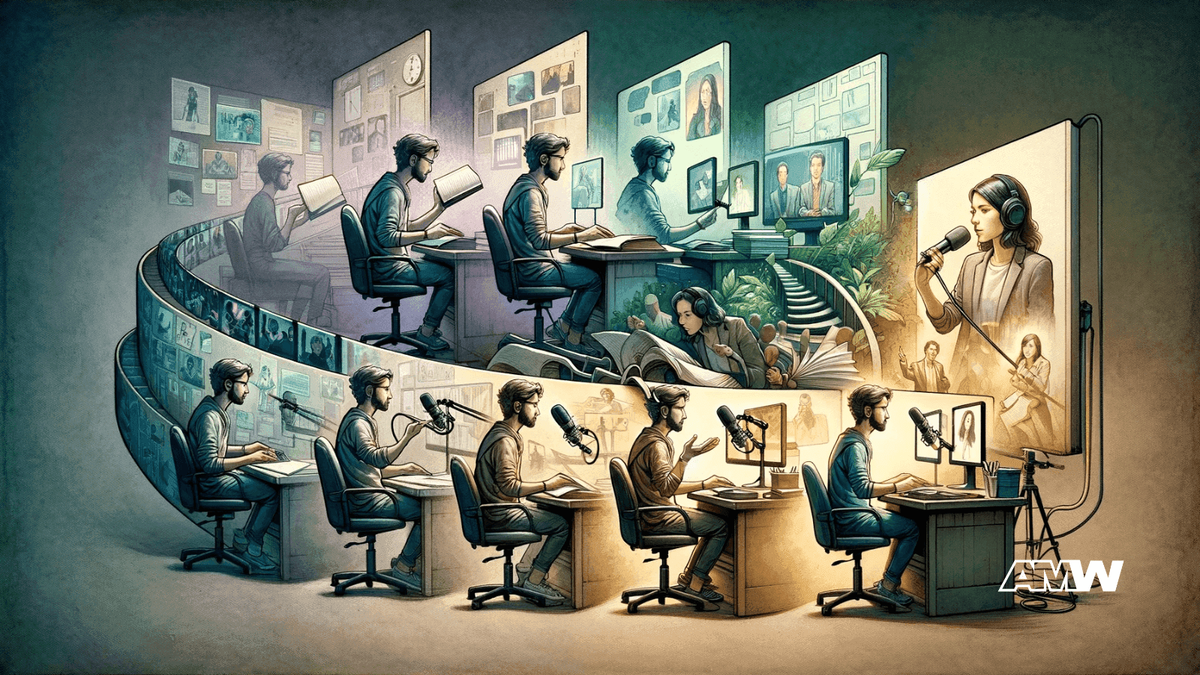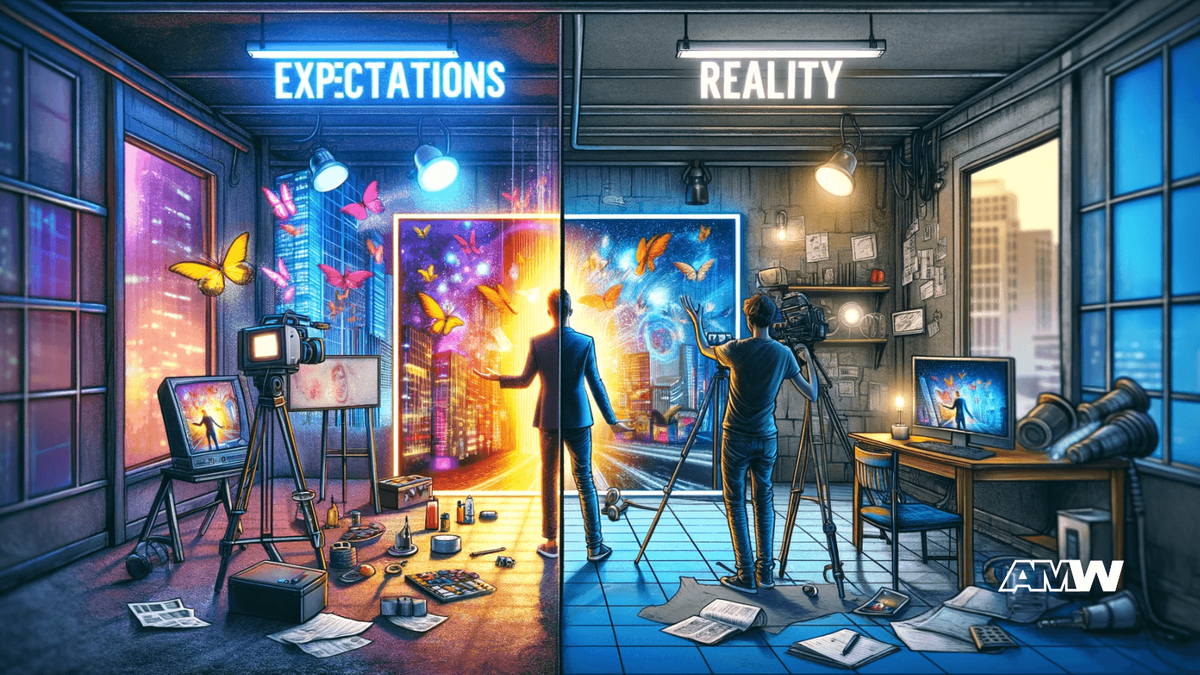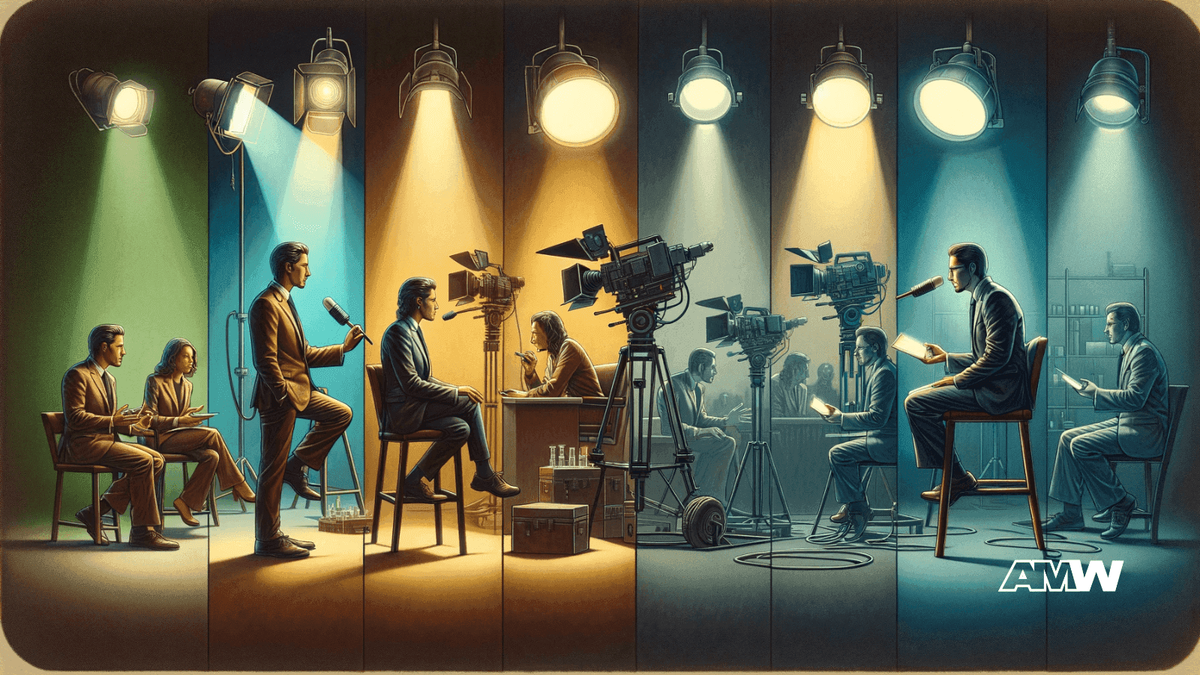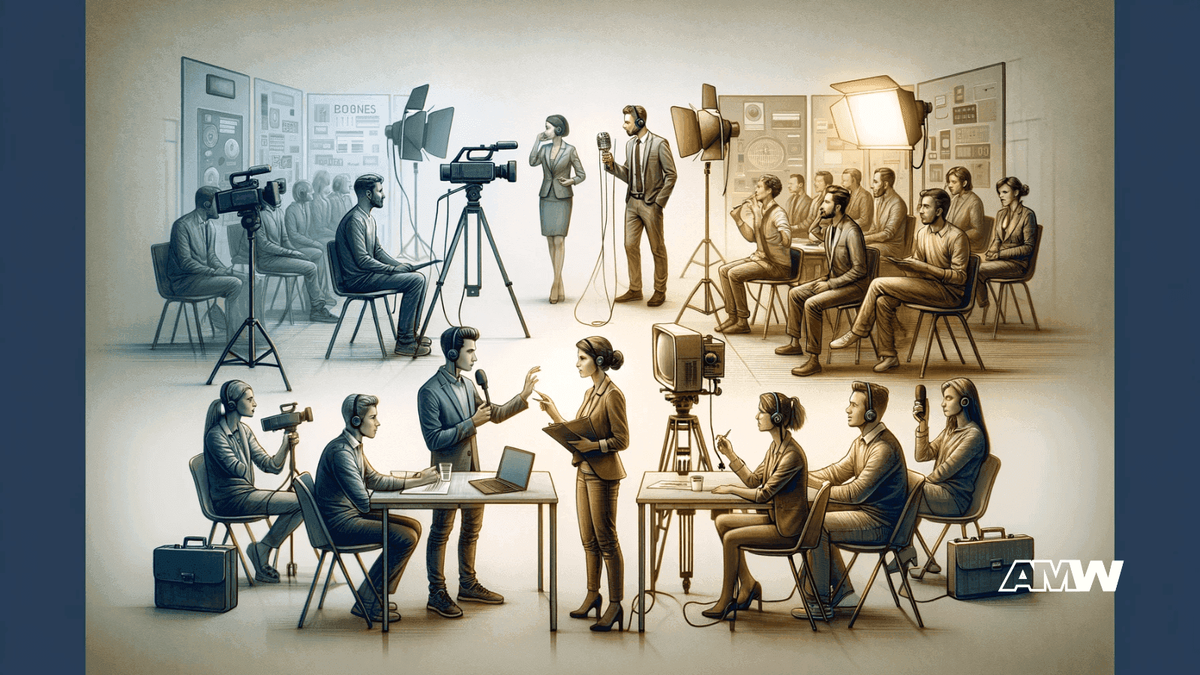From Camera Shy to Media Pro: The Best Media Training Secrets

Where media training is not just a luxury but a necessity, understanding its immense importance and benefits has never been more crucial. For many, the mere thought of facing a camera or a reporter's question can be daunting. Yet, in media relations and coverage, clearly and concisely communicating your story, message, or business is key to capturing your audience's attention.
Quick Summary
Media training is essential for effective communication, empowering individuals to deliver messages confidently during interviews. It encompasses mastering key skills such as body language, answering tough questions, and crafting concise sound bites. With proper preparation and practice, one can navigate various media interactions, ensuring clarity and engagement with the audience. Beyond handling interviews, media training enhances public perception, professional growth, and leadership skills,
Imagine yourself in a television interview or at a press conference. The lights are bright, the camera is about to hit record, and it's your time to shine.
How do you ensure that your key messages are not only heard but resonate with your intended audience?
Ready to Grow Your Business?
Get a free consultation and custom strategy tailored to your goals.
Whether it's mastering the art of body language, refining your ability to answer tough questions, or learning to speak in sound bites, media training tips and techniques are vital tools in your arsenal.
Media interviews, whether they are for television, radio, or even live to tape offer unique interview opportunities to share your story, point, and message. However, without proper preparation, you might find yourself answering questions off-topic or, worse, saying the wrong thing.
That's where media training courses come in - to help you develop and practice the skills needed to handle interviews and conversations with journalists confidently and effectively.
But it's not just about what you say; it's about how you say it. Small details, such as making eye contact and using your own words when responding to a reporter's question, can significantly impact how your message is received. The same rules apply when dealing with difficult questions during live television or radio interviews.
It's about staying on point, maintaining context, and ensuring your most important points are delivered in a concise manner.
As we explore the various aspects of media training, remember that the journey from camera shy to media pro is not just about learning to answer the reporter's question; it's about engaging in a meaningful conversation with your audience.
With each section, you will gain insights on how to prepare, anticipate questions, and deliver your message in a way that not only informs but also inspires.
Understanding Media Training
Definition and Purpose
Media training, at its core, is an empowering process designed to equip individuals with the skills to communicate effectively, confidently, and persuasively in various media settings.
Media training aims to prepare individuals to deliver their message concisely and convincingly, whether it's a television interview, press conference, or radio show. This training is not just about handling tough questions or staying on point; it's about crafting and conveying your story and your message in a way that captures and retains your audience's attention.
Media training guides you to develop the confidence and competence to stand before a camera, face a reporter, and engage in a meaningful conversation with your intended audience.
The Scope of Media Training
Media training is vast and varied, offering a range of courses and tips tailored to different needs and scenarios.
From basic media training courses that cover the fundamentals of interviewing and body language to advanced programs focusing on handling difficult questions and delivering sound bites effectively, there is a spectrum of training available. These sessions are designed to teach you how to anticipate questions, answer concisely, and use your own words to deliver your main points effectively.
Whether it's live television or a live-to-tape interview, understanding the different types of media training available helps you choose the right one that aligns with your specific needs and interview opportunities.
Media Training for Celebrities
For public figures and celebrities, media training takes on an additional layer of complexity. The spotlight is brighter, the stakes are higher, and the audience is often more extensive and diverse.
Media training for celebrities involves specialized techniques to handle their unique challenges, such as intense media scrutiny, highly publicized press conferences, and the need to consistently deliver memorable messages that resonate with a wide audience.
In these scenarios, the same rules apply, but with greater emphasis on maintaining a consistent image, managing public perception, and navigating the intricacies of celebrity media relations.
Celebrities must learn to use media interviews as a platform to answer questions and as a strategic opportunity to shape their narrative, engage with their fans, and enhance their public persona.
Understanding media training is about recognizing its role as a vital tool in your communication arsenal. Whether you're a business professional, a rising star, or someone aiming to improve your public speaking skills, media training equips you with the techniques to talk confidently, answer questions effectively, and turn every media interaction into a chance to deliver powerful, effective messages.
It's about being prepared, practicing, and ultimately standing in front of the camera or microphone with the confidence and clarity that captivates your audience.
The Process of Media Training

Key Components of Media Training
Embarking on media training is like setting off on a personal and professional transformation journey. The key components of media training courses are meticulously designed to turn you into an effective communicator capable of handling media interviews with poise and confidence.
These sessions typically cover various aspects, including:
- Understanding Media Relations: Grasping the dynamics of media coverage and how journalists operate is crucial. It helps you understand the context in which your messages will be received.
- Crafting Key Messages: Learn to distill your story, business, or point into memorable messages that resonate with your intended audience.
- Effective Speaking Techniques: From using your own words to speaking clearly and concisely, these techniques ensure that your key points are communicated effectively.
- Body Language and Eye Contact: Non-verbal cues are as important as your words. Mastering body language and maintaining eye contact are essential for creating a positive impression.
- Handling Tough Questions and Difficult Situations: Prepare for challenging questions and develop strategies to steer the conversation back to your main points.
- Sound Bites and Media-Friendly Responses: In a world where sound bites often become the highlight of an interview, learn to deliver powerful, concise responses.
Developing Key Messages
The art of media training goes beyond just answering questions; it's about taking control of the interview narrative. Developing key messages involves a strategic process where you identify the most important points you want to convey and tailor them to capture your audience's attention.
This involves:
- Analyzing Your Audience: Understanding who you are talking to helps in crafting messages that resonate with them.
- Creating Impactful Statements: Your key messages should be relevant and easily understandable to ensure they stick with your audience.
- Consistency Across Platforms: Whether it's a television interview, a press conference, or a radio interview, your key messages should remain consistent across all media platforms.
Preparation Strategies
Preparation is the bedrock of effective media training. Before you hit record or stand before the camera, significant groundwork needs to be done.
Preparing for a media interview effectively involves:
- Research and Anticipation: Anticipate the reporter's questions and prepare your answers. Understand the context of the interview and align your messages accordingly.
- Practicing: Rehearse your key points, responses to potential tough questions, and practice delivering them in a concise manner. Use video practice to refine your body language and speaking style.
- Staying Informed and Updated: Keep abreast with current statistics, trends, and relevant information that could be useful in your interview.
- Mental and Physical Preparedness: Being confident and calm during an interview is as crucial as knowing your material. Practice mindfulness and relaxation techniques to maintain composure.
Remember, media training is not just about learning to talk to the media; it's about learning to communicate and convey your story, point, and message in the most effective way possible.
Whether it's a live television interview or a conversation with a reporter, each media interaction is an opportunity to deliver your key messages confidently and leave a lasting impression on your audience.
So, embrace these components, develop your key messages, and prepare thoroughly – the stage is yours to own.
Learning and Practicing Media Skills

Training Methods
Diving into the world of media interviews, it's essential to embrace various training methods to sharpen your skills. Media training isn't a one-size-fits-all solution; it's a journey of finding what works best for you and your message.
Ready to Grow Your Business?
Get a free consultation and custom strategy tailored to your goals.
Here are different approaches to consider:
- Professional Media Training Courses: These courses are structured and led by experienced media trainers and journalists. They offer a comprehensive understanding of how to navigate media interviews and often include mock interviews and real-time feedback.
- Workshops and Seminars: Participating in workshops provides interactive and hands-on learning experiences. They are ideal for practicing speaking and interviewing skills in a group setting.
- Online Learning Platforms: With the digital age, numerous online courses and webinars offer flexibility and a wealth of information at your fingertips. They are great for learning at your own pace.
- One-on-One Coaching: Media training experts offer personalized coaching sessions tailored to your needs, focusing on your key messages and interview style.
Getting Media Trained
Embarking on your media training journey can seem daunting, but there are several avenues to explore:
- Hiring a Media Training Firm: These firms specialize in preparing individuals and businesses for media engagements. They provide expert guidance and tailored training to enhance your interviewing skills.
- Joining Media Training Workshops: Offered by various organizations, these workshops provide practical experience and networking opportunities with professionals and journalists.
- In-House Training Programs: Many organizations have in-house media training programs for their employees, especially those in public-facing roles or corporate communications.
- Industry Conferences and Events: Often, these events have sessions dedicated to media training, offering a chance to learn from experienced speakers and media professionals.
DIY Media Training
For those who prefer a more self-directed approach or are looking for ways to supplement formal training, DIY media training can be a powerful tool:
- Study and Analyze: Watch interviews of effective communicators and note their key message delivery, body language, and how they handle tough questions.
- Record and Review: Practice your interviews on camera. Reviewing your videos helps identify areas for improvement, be it in body language, how you answer questions, or maintaining eye contact.
- Gather Feedback: Share your practice videos with trusted colleagues or mentors for constructive feedback.
- Stay Informed: It's important to stay up-to-date with current events and statistics that are relevant to your business or industry. This will allow you to conduct more engaging interviews with journalists and add more depth to your conversations.
- Regular Practice: Consistent practice is key. Whether it's rehearsing your key points, engaging in mock interviews, or simply talking in front of a mirror, regular practice builds confidence and preparedness.
Whether you choose professional courses, workshops, personal coaching, or a DIY approach, the essence of media training lies in your willingness to learn, adapt, and continually hone your skills.
Remember, each interview is a story-telling opportunity – a chance to convey your message, point, or story in a way that resonates with your audience and leaves a lasting impact.
Embrace these methods, and step into your next media engagement with the confidence and clarity of a true media pro.
Practical Aspects of Media Training

Expectations vs. Reality
Media training is a transformative journey, but it's important to set realistic expectations. While it provides you with the tools and techniques to handle media interviews effectively, it does not guarantee perfection in every interview.
Here's what you can realistically expect:
- Improved Communication Skills: You'll learn to deliver your key messages in a more clear and concise manner, making your points more digestible and impactful for your audience.
- Increased Confidence: Regular practice and training will boost your confidence, especially when dealing with tough questions or challenging interviewers.
- Better Message Control: You'll gain skills to steer conversations back to your main points, ensuring your key message is not lost in the interview.
- Enhanced Non-Verbal Communication: Media training helps improve your body language, eye contact, and overall presence on camera.
However, remember, each interview is unique, and media training is about equipping you to handle various scenarios, not scripting your every response.
Navigating Media Interviews
Navigating media interviews requires a blend of preparation, presence of mind, and adaptability.
Here are some practical tips:
- Understand the Interview Format: Whether it's live television, a radio interview, or a press conference, understanding the format helps you prepare your responses accordingly.
- Anticipate and Prepare for Questions: Most journalists will have a set of questions prepared. Anticipate these and practice your answers, but be ready to adapt as the interview progresses.
- Stay On Message: Keep bringing the conversation back to your key points. This ensures that your main message is communicated effectively to your audience.
- Handle Difficult Questions Gracefully: When faced with tough questions, stay calm and use techniques learned in media training to provide thoughtful, measured responses.
- Engage with the Interviewer: Treat the interview as a conversation, not an interrogation. Engaging with the interviewer can make the interaction more natural and less stressful.
The Role of Media Training in Career Development
Media training is not just about handling interviews; it's a valuable tool for career advancement and enhancing your public perception.
Ready to Grow Your Business?
Get a free consultation and custom strategy tailored to your goals.
Here's how:
- Professional Growth: Effective communication skills are critical in the business world. Media training helps you articulate your thoughts in a more structured and impactful way, beneficial in various professional scenarios.
- Networking Opportunities: As you become more adept at handling media interactions, it opens up opportunities for networking with journalists, influencers, and industry peers.
- Leadership Skills: The confidence and communication skills gained from media training translate into stronger leadership qualities, as you're able to convey your vision and ideas more effectively.
In essence, media training is an investment in yourself. It equips you with the skills to handle media interactions with poise and confidence, ensuring that your message resonates with your audience, whether it's in a media interview, a business meeting, or a public speaking engagement.
As you continue to grow and develop these skills, you'll find that they not only enhance your ability to communicate effectively but also open doors to new professional opportunities and elevate your personal brand.
Beyond the Basics

Advanced Techniques
Once you've mastered the fundamentals of media training, it's time to explore advanced techniques that can further elevate your media interview skills. These strategies are designed for individuals who are already comfortable in front of the camera and are looking to refine their approach to become more impactful and engaging.
Here are some advanced techniques to consider:
- Controlling the Narrative: Learn to guide the interview in a direction that aligns with your goals. This involves subtly shifting the focus back to your main points, even when the interviewer veers off topic.
- Handling Crisis Situations: In high-pressure situations, such as crisis interviews, the ability to remain calm and provide clear, concise answers is crucial. Advanced training includes strategies for maintaining composure and delivering your message effectively under stress.
- Storytelling Techniques : Enhance your ability to tell compelling stories that resonate with your audience. This involves using anecdotes, examples, and metaphors to make your messages more relatable and memorable.
- Dealing with Multiple Reporters: Learn strategies for handling press conferences or panel interviews where you have to address questions from multiple reporters.
- Refining Your On-Camera Presence: Advanced media training often includes detailed feedback on your on-camera presence, including refining your body language, vocal tone, and overall delivery to be more engaging.
Digital Media Considerations
Media training must address challenges and opportunities of digital media.
Here's how you can adapt:
- Engaging in Video Interviews: With the rise of video conferencing, learn how to engage effectively in media interviews conducted over digital platforms. This includes understanding camera angles, lighting, and ensuring a professional background.
- Social Media Savvy: Understanding how to interact with journalists and your audience on social media platforms is essential. This includes responding to comments, using hashtags effectively, and maintaining a consistent message across platforms.
- Creating Engaging Content: Learn how to create content that resonates with your digital audience. This could be short video clips, blog posts, or social media updates that effectively communicate your key messages.
- Managing Online Reputation : Media training for the digital age includes tips on monitoring and managing your online presence and responding appropriately to both positive and negative feedback.
- Digital Crisis Management : Gain insights into managing crises in the digital space, where news and rumors can spread rapidly. Learn strategies for quick, transparent, and effective communication to mitigate negative impacts.
Remember, the journey of mastering media training is ongoing.
By embracing advanced techniques and adapting to an evolving media landscape, you can enhance your ability to communicate effectively and stand out as a confident and compelling voice in your field.
Keep pushing your boundaries, stay prepared, and continue to evolve – your audience is waiting to hear your story.
Conclusion

As we conclude this empowering journey through the world of media training, let's reflect on the key takeaways and the transformative path from being camera-shy to becoming a media pro.
- Understanding the Basics: Grasping the fundamentals of media training sets the stage for effective communication. Remember, the goal is to deliver your main points in a clear and concise manner that resonates with your audience.
- Practicing and Refining Skills: Consistent practice and refinement of skills are crucial. Whether it's a media interview, a press conference, or a digital interaction, being prepared and rehearsed makes a significant difference.
- Crafting Your Story: Your story, message, or point is unique to you. Learn to communicate it in a way that captures the interviewer's and audience's attention, making each response meaningful and impactful.
- Adapting to Different Formats: Whether it's responding to reporters in a press conference, talking in front of a camera, or engaging in a video interview, adapt your approach to suit different media formats and settings.
- Embracing Advanced Techniques: As you grow more comfortable, explore advanced media training techniques. These will help you handle more complex situations, control the narrative, and engage more effectively with your audience.
- Digital Media Skills: Learning to navigate social media and online platforms is as important as traditional media skills. This includes creating engaging content, managing your online reputation, and interacting effectively with your digital audience.
Now, as you step forward, take these media training tips and insights with you. Embrace the journey from being camera-shy to becoming a media pro.
It's a path filled with learning, growth, and countless opportunities to share your story, answer the call of each interviewer, and connect with your audience in meaningful ways.
Remember, every media interview, every conversation with a reporter, and every moment in front of the camera is an opportunity to shine, to share your message, and to make an impact. Stay curious, stay prepared, and most importantly, stay true to your voice.
You have the tools; you have the knowledge – now go out there and captivate your audience!
Ready to Grow Your Business?
Get a free consultation and custom strategy tailored to your goals.
Related Articles

Behind Tomorrowland’s Rise to a Multi-Million Euro Cultural Movement
When Tomorrowland Belgium sells out 400,000 tickets across two weekends in less than an hour each year, it's not merely luck or lineup strength driving those numbers. The festival has engineered one o

Philips Bodygroom as a Case Study in Bold Marketing and Consumer Insight
The men's grooming industry has undergone a dramatic transformation over the past two decades, moving from basic necessities to comprehensive personal care routines. Within this evolution, few brands

Inside the Timeless Appeal of America’s Favorite Oat Circles - Cheerios
When General Mills introduced Cheerios to American breakfast tables in 1941, no one could have predicted that these simple whole grain oats circles would become one of the most recognizable brands in